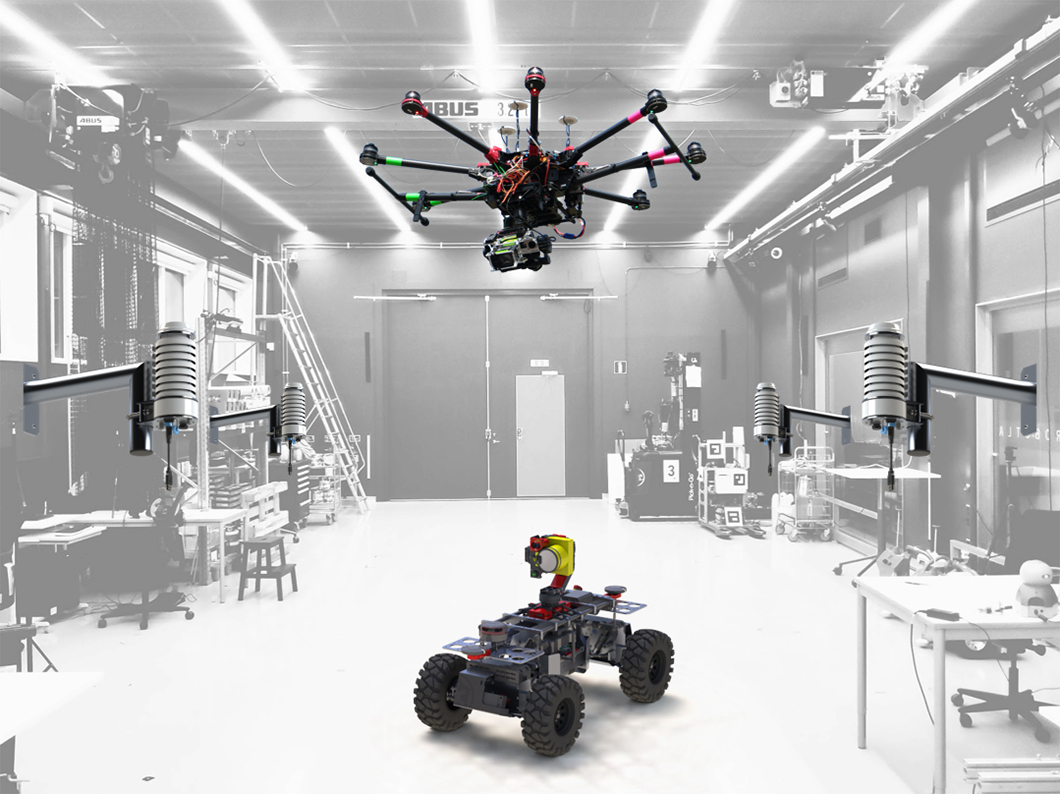
Smart sensor network consisting of stationary sensor nodes and mobile sensor technology on drone and ground robot.
Source: BAM
Project period
01/04/2019 - 31/12/2022
Project type
EU project
Project status
Closed
Description
A smart network consisting of stationary and mobile sensors monitors the distribution of air pollutants in several real industrial environments. This enables targeted health protection measures.
Location
Bundesanstalt für Materialforschung und -prüfung (BAM)
Unter den Eichen 87
12205 Berlin
Smog after rain in an industrial environment Source: Leonardo0511 / CC BY-SA 4.0 
Particularly in factories, gases and fine dusts that are harmful to health can be released by the ongoing process steps. In order to effectively protect the health of employees in industrial environments, a precise knowledge of the existence and distribution of these air pollutants is necessary. However, with conventional measurement methods it is difficult to take into account the dynamics of turbulent air movements, which is why the exact spatial and temporal distribution of pollutants often remains unclear.
Source: BAM
A precise understanding of the spatial and temporal distribution of air pollutants is necessary for targeted health protection measures. Three-dimensional maps will visualise the spatial and temporal distribution of dusts and gases and serve as a basis for designing improved health protection measures. Long-term monitoring of the environment will also reveal the influence of periodic events, for example in manufacturing processes.
Source: BAM
A dense network of low-cost stationary sensors collects environmental data. A few high-quality sensors on mobile platforms (drones and ground robots) complement the sensor network. However, the data obtained are of varying qualities. The further development of algorithms will make it possible to create improved environmental models from the data to depict air pollutant distributions.
Source: BAM
Project coordination
Bundesanstalt für Materialforschung und -prüfung
Project partners
Bundesanstalt für Materialforschung und -prüfung
FIOH Finnish Institute of Occupational Health
AASS Mobile Robotics & Olfaction Lab, Örebro University
Funding
The RASEM project is funded by the European partnership organisation SAF€RA.
RASEM - Robot-assisted Environmental Monitoring for Air Quality Assessment in Industrial Scenarios
Air pollution affects us all
Nine out of ten people worldwide breathe polluted air. In the European Union alone, 400,000 premature deaths are therefore attributed to polluted air every year. Air pollution is a problem for each and every one of us and must be tackled on multiple different areas. The RASEM project focuses on monitoring air pollutants in industrial environments. In a steel factory, for example, ongoing industrial processes can release dust particles and toxic gases that are extremely harmful to the human body. To minimise the exposure of workers to polluted air, accurate knowledge of the distribution of air pollutants factories is necessary.
Approaches to environmental monitoring
In reality, it is very difficult to determine the distribution of air pollutants in an area because air particles are distributed by complex physical processes. Health experts who try to quantify the concrete risks to the human body can usually only carry out measurement campaigns on individual days of the year, which is why seasonal influencing factors are often not taken into account. In addition, depending on the size of the environment, numerous individual measurements are necessary, which means that the dynamic distribution of air pollutants can often only be recorded incompletely.
To explore new approaches to environmental monitoring, a combined system of stationary sensors and mobile robots are being developed within RASEM and tested indoors and outdoors in real industrial environments.
Improved environmental models through intelligent data evaluation
With the help of algorithms, 3D distribution maps of air pollutants are created from the recorded measurement data. In contrast to highly complex numerical solutions, which have to be adapted to each specific scenario in a time-consuming process and crucially depend on exact knowledge about the environment at any instant, the models that BAM is researching should be as easily adaptable as possible to new scenarios. This should enable flexible use of the system and algorithms developed within RASEM in other areas as well.
In the future, the mobile robots will be able to autonomously explore an area through interaction with the stationary sensors and intelligently determine the different concentration levels of air pollutants.
Project coordination
Bundesanstalt für Materialforschung und -prüfung (BAM)
Division Sensors, Measurement and Testing Methods
Project partners
Bundesanstalt für Materialforschung und -prüfung (BAM)
FIOH Finnish Institute of Occupational Health
AASS AASS Mobile Robotics & Olfaction Lab Örebro University
Funding
The RASEM project is funded by the European partnership organisation SAF€RA. Source: RASEM | Saf€ra



